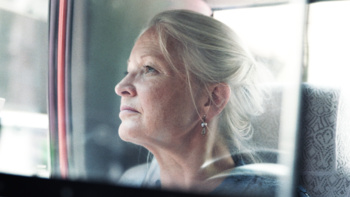Dreaming Murakami – Making literary translation visible
10.9.2018 klo 13:00
 “There's no such thing as a perfect piece of writing, just like there's no such thing as perfect despair.”The documentary film Dreaming Murakami (Final Cut for Real, 2017) begins with this opening line from Haruki Murakami’s Hear the Wind Sing. The sentence forms a common thread, which is woven into the fabric of the whole film. Dreaming Murakami captures the process of literary translation onto film, which is a previously overlooked subject matter for documentaries. Directed by Nitesh Anjaan, the film focuses on Murakami’s Danish translator, Mette Holm, providing an intimate and often sympathetic glimpse into the work of a literary translator at the height of her craft. Holm, who has been a translator for over 20 years, has translated a staggering 17 books by the prolific Japanese author. Dreaming Murakami follows Holm for a year in Denmark and Japan while she translates the magical realist’s debut novel, Hear the Wind Sing. Holm has agreed to do an interview to discuss Dreaming Murakami that had its Finnish premiere at this year’s DocPoint film festival. I reach the translator at her home in Denmark in the middle of a cold spring morning. The interview, conducted via Skype, is paused while she goes to add some logs to her wood stove. At the time of the interview, the busy translator is fighting a deadline as she is finishing the translation of Murakami’s latest book, the 1,000-page long Killing Commendatore. Holm tells us that she met Anjaan at a university lecture that she was giving on Murakami. The young director was only 21 years old, “and very handsome”, she adds with a giggle. They bonded over Murakami and formed a close friendship. Then, one day Anjaan expressed the desire to make a documentary film focusing on Holm. At first, Holm was hesitant. “Translating is such a vulnerable job and you can feel very exposed. It is difficult to get a translation right, so letting someone in on your process can be scary.” But Anjaan persuaded her. “And besides”, she adds: “He did not want to make a film about the hardships of translating – he did not focus on the long hours and low pay, but instead created a poetic movie.” The documentary shows Holm’s conversations with her fellow translators, portraying them as a very close-knit group. Holm stresses that the support and advice of her peers are very important to her. “The work of a translator can be very lonely, so it helps to have other people that you can discuss these strange things with.” In the early 2000’s there was a big Murakami seminar in Japan, with Murakami translators from 14 countries. “But no Murakami”, she laughs. Since then, she has communicated directly with the author. “We ask him some questions, but often he does not answer them. Often, he just says that I am the translator, so I should translate the text using my best judgement. He is a very busy man”, Holm explains and adds that Murakami’s books are translated into 55 different languages. Although Murakami himself is not featured in the documentary film, his presence is felt everywhere. Holm explains that literary translators get very close to the authors of the works that they are translating. “There are so many habits, like expressions and images, that somehow reflect what kind of person the author is”, she explains. Like Murakami’s writings, the Japanese language also reflects a reality that may seem foreign to us Westerners. Holm stresses that it is extremely important for the translator to be immersed in Japanese culture. “Japanese people think in a totally different way,” she explains. “Logic is different in Japanese. A lot is left unsaid – you express more with fewer words and leave room for interpretation.” Indeed, Holm seems very much at home in Murakami’s world, where the line between reality and fiction sometimes begins to blur. This brings us to Holm’s coprotagonist: the documentary features a giant animated frog, aptly named Frog. According to Holm, the frog came to Anjaan in a dream. Frog represents the current world situation and the translator’s role as a mediator. “But most of all, it symbolises the Japanese concept of the two different levels of reality”, she adds. Frog asks Holm to join him in a difficult battle and warns her that nobody will know the struggles they will endure, not even if they win. This can be seen as a metaphor for the often invisible work of a translator, but Holm feels that, in Denmark, there has been a shift in attitudes of late. “I would say that the situation is gradually improving. Translators have gained more visibility and literary translations are discussed more widely in the media.”
Interview: Maarit Laitinen
Dreaming Murakami will be released on iTunes in December. The next screenings of Dreaming Murakami in Finland:
|
 Suomen kääntäjien ja tulkkien liitto
Suomen kääntäjien ja tulkkien liitto